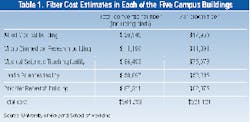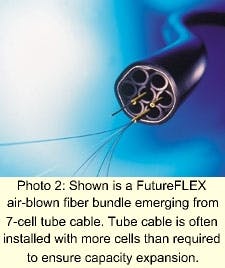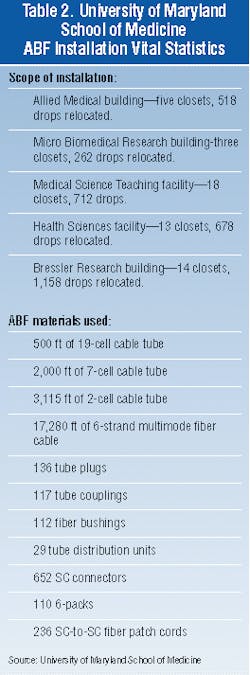Anatomy of a campus upgrade to an air-blown fiber cabling system
Jim Allen
Sumitomo Electric Lightwave Corp.
Deborah Finkelsen, assistant dean of information services, and Bob Heron, director of technical services, led the team responsible for planning the School of Medicine's local-area-network upgrade. High on the list of priorities for the network were optimum flexibility and reliability. The ability to reconfigure the network as required, without undue labor and expense was paramount. The new network also has to facilitate moves, additions, and changes with minimal disruption to existing operations, especially since reliable data transmission is essential to many of the School of Medicine's educational, research, and medical activities.
While the School of Medicine's network is currently used for data transmission, supporting a variety of applications and database systems, this setup will change as the modernization progresses. "We plan to begin expanding services that will support audio and video applications as part of our distant-learning technology," says Finkelsen.
The decision was made to replace the network's copper ThickNet coaxial backbone with a fiber-optic cabling system. The School of Medicine's technical team sourced quotes from several suppliers of conventional fiber-optic systems. For comparison, they also obtained cost estimates for an air-blown fiber-optic cabling system (see Table 1).
"When we found that the cost estimates were almost the same for both systems, we decided the air-blown fiber [ABF] system offered more advantages and a better value proposition for the investment," explains Heron.
The technical team decided to install air-blown fiber-cable plants in each building, using a collapsed backbone topology running Fast Ethernet (100 Mbits/sec) to a main distribution frame. Cisco Systems' 5500 switching technology completed the interfaces from the backbone to the existing horizontal cabling throughout the buildings.
With proper design and installation, air-blown fiber-optic cabling systems can deliver all the benefits of fiber-optic transmission but without the high infrastructure investment and ongoing maintenance costs of conventional fiber systems. ABF systems are typically less expensive to upgrade or reconfigure as the network evolves and requirements change.At the heart of the ABF system is an infrastructure of rugged, flexible tube cable used in place of conventional innerduct. The tube contains up to 19 coded tube cells, which can be joined in tube distribution units (TDUs), or junction boxes, using simple push-fit connectors (see Photo 1). TDUs replace conventional fiber splice hardware at tube-cable transitions and branching locations to provide point-to-point connectivity between the computer room or network hub and the application. The fibers come in bundles ranging from two to 18 fibers each to deliver a maximum capacity of 342 fibers in a 19-cell tube cable.
Once the tube-cable infrastructure is in place, lightweight bundles of singlemode or multimode optical fiber are blown at speeds of up to 150 feet per minute through a predefined route on a stream of nitrogen, using specially designed equipment. Installation is fast, typically requiring no more than two trained technicians. Cable runs may exceed 6,000 feet and the fiber path may traverse outdoor, riser, and plenum tubes in a single run. Since the fibers are blown rather than pulled, installation damage is not an issue.
In almost all ABF installations, tube cable is installed with more cells than are currently required to ensure room for expansion (see Photo 2). Unused cells are capped off within the TDUs until needed. Network expansion or reconfiguration can be done quickly by extending tube cables from the nearest TDU. Fiber bundles can be upgraded or replaced by blowing cable through unused cells or by blowing out old fiber (which can be reused) and blowing in new-all without disrupting the existing network.
Space utilization is also maximized, since ABF bundles do not require a strength member and are significantly smaller than conventional fiber cables. Typical fiber-optic cable, for example, is approximately 1/2 to 1 inch in diameter, while an ABF bundle measures 1/16 to 1/4 inch.
The School of Medicine's migration to the switched-network technology started in October 1998 with the installation of the rack-mount equipment and the conversion of the 110 wiring fields to patch panels. The switched network uses Cisco 5505 and 5500 modules in each building to accommodate all user counts. The technical team selected Cisco's Catalyst 5000 series because of its advanced multiprotocol switched-network topology, which is required to support the various applications on the network. The switches provide a powerful backbone solution to transmit the heavy browser-based traffic from the School of Medicine's intranet.That was followed by installation of the ABF system. The ABF cabling was installed in the major School of Medicine buildings as the backbone structure, where it supports existing Category 3 and Category 5 copper cable for the horizontal connections. All communications closets are homerun to the main distribution frame in each building. To date, the network upgrade has involved a total of five buildings and 53 telecommunications closets, with 3,328 drops being installed and/or relocated.
The average fiber run is between 300 and 500 m; the longest is about 800 m. To date, the installation team has deployed over 5,500 ft of cable tube (2-, 7- and 19-cell) and over 17,000 ft of 6-strand multimode-fiber cabling (see Table 2).
"One of the things we appreciate most about the ABF cable tube system is its security," says Heron. "The system is totally closed and does not present any opportunity for individuals to use it as a conduit for unauthorized cabling. That's reassuring."
For the first phase of the LAN modernization, Heron was the system designer and Bell Atlantic Data Solutions Group (BA-DSG-Columbia, MD) was the systems integrator for the project.
"Installation of the air-blown fiber went very smoothly, with no surprises or additional costs," observes Heron. "As we discovered, the ABF system takes up very little space in our wiring closets, a real plus for an already over-utilized environment."
Both Finkelsen and Heron point to early indications that the network investment is going to payoff-network stabilization and improved performance as well as uptime. As a result of the network upgrade, the School of Medicine's new $32-million Health Sciences building now incorporates fully networked, state-of-the-art workstations that provide unprecedented possibilities for future applications. The smaller buildings will also be outfitted with Cisco switching technology over the next year or so until all buildings are linked within a single switched network.
"From a communications point of view, the new system positions us extremely well for the future," says Heron.
In Phase II, the technical team is also planning to use ABF cabling. Renovation work on Howard Hall and construction of a new addition to the Health Sciences facility is scheduled for later this year. The campus modernization is expected to continue throughout this decade with a third addition planned for the Health Sciences building.
In the next phase, the fiber installation will be handled by BA-DSG and authorized ABF contractor Comret Inc. (Philadelphia). "You would think that continuing a network installation begun by another contractor would be challenging, but with ABF, it's not," asserts Kevin Finley, president of Comret. "In a conventional fiber installation, with three installers on the job, we estimate the next phase will take about 3 1/2 weeks to pull the fiber. With ABF, we expect it to take less than two weeks."
"Today, with universities competing and under pressure to do more with less, sound financial management and far-sighted economies are key to success," says Finkelsen. "We are confident the ABF backbone is capable of growing as the medical school grows because it has built-in flexibility to handle change. In fact, as applications demand and pricing becomes even more attractive, we may consider implementing ABF cabling to the desktop."
Jim Allen is a product marketing manager at Sumitomo Electric Lightwave Corp. (Research Triangle Park, NC).


